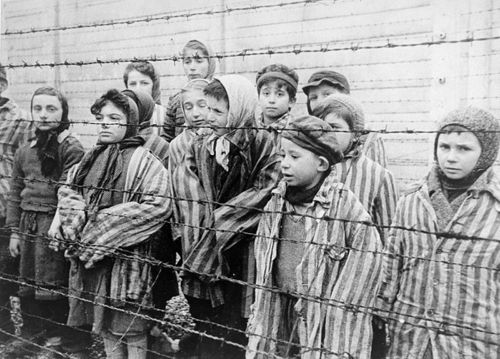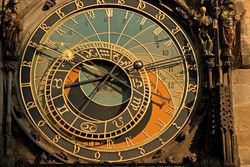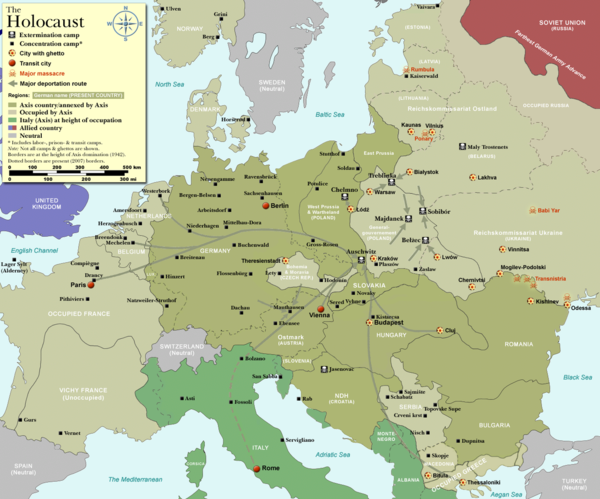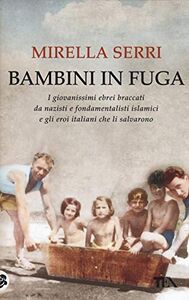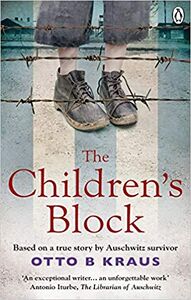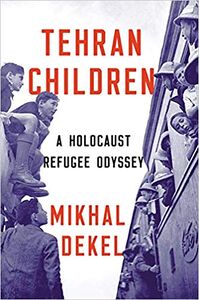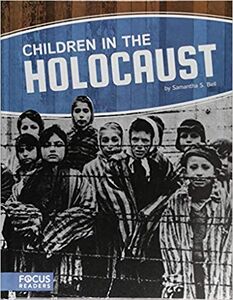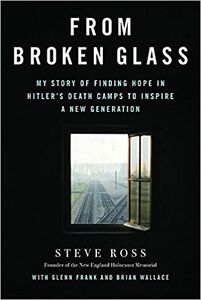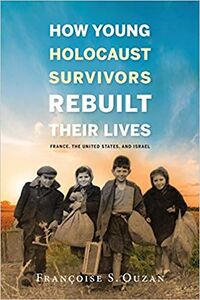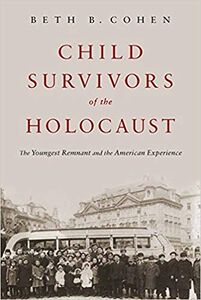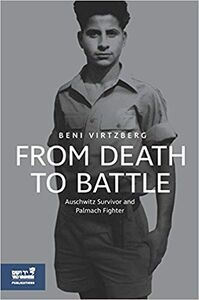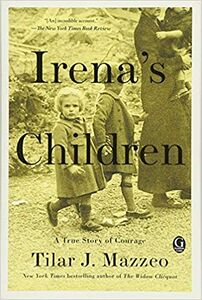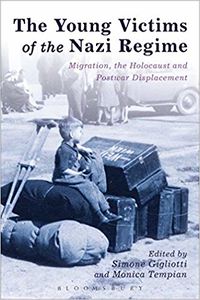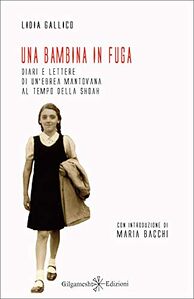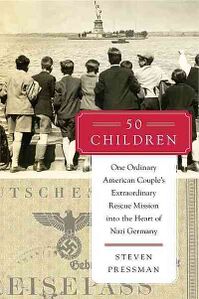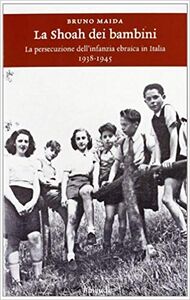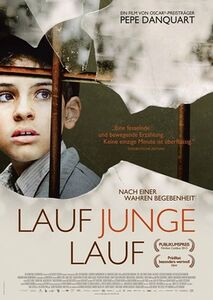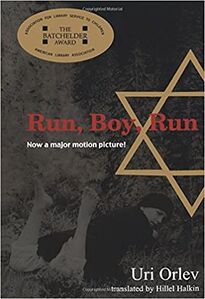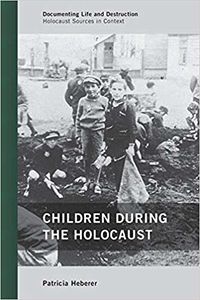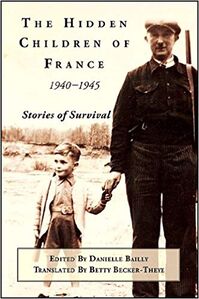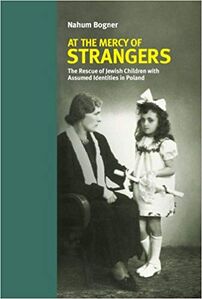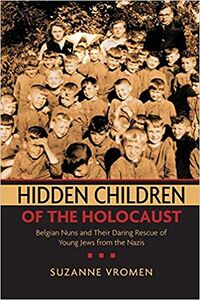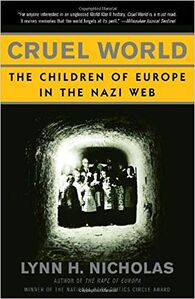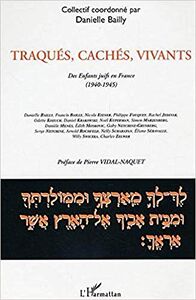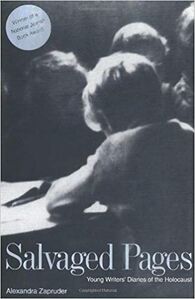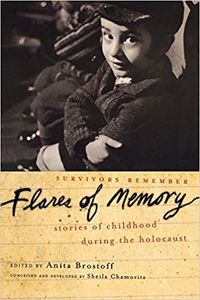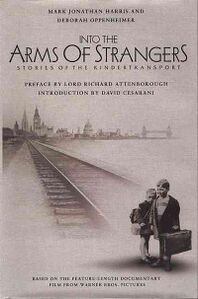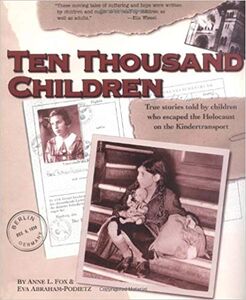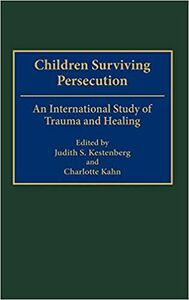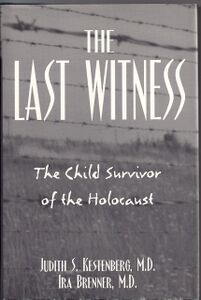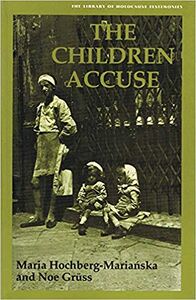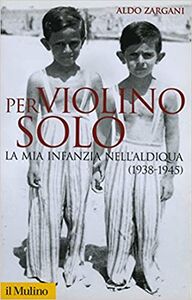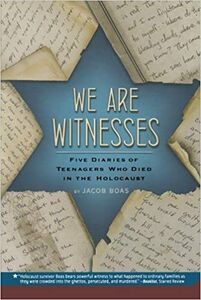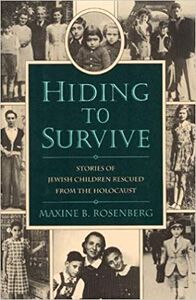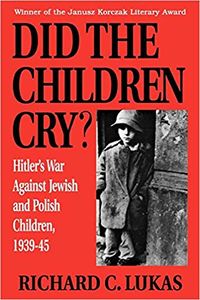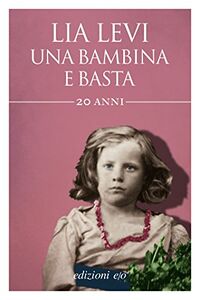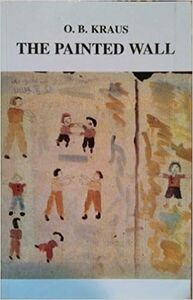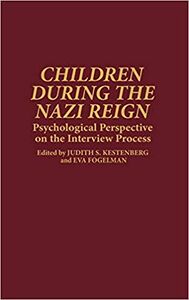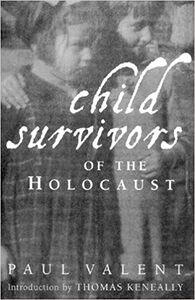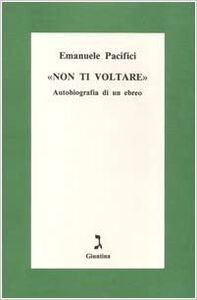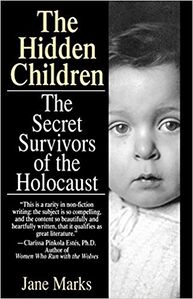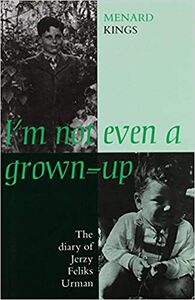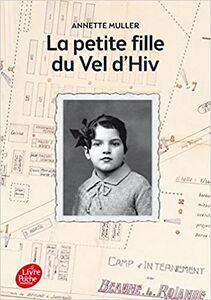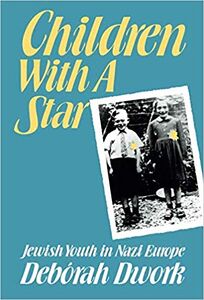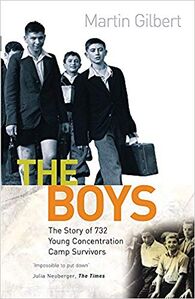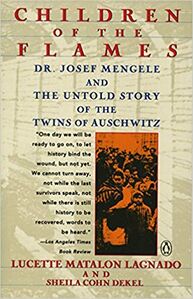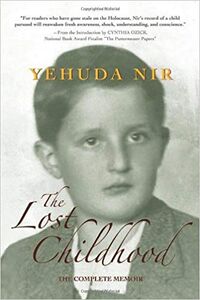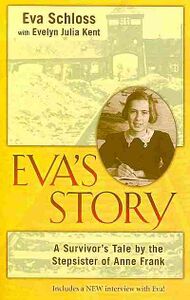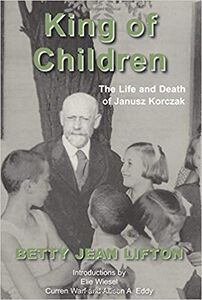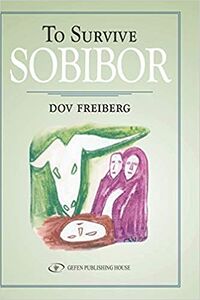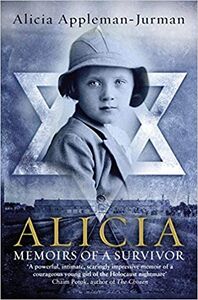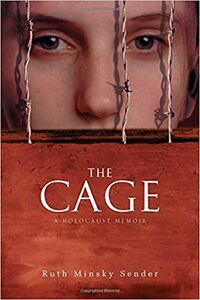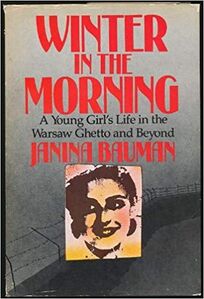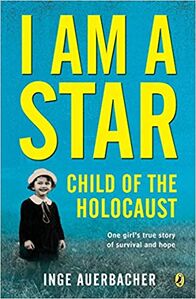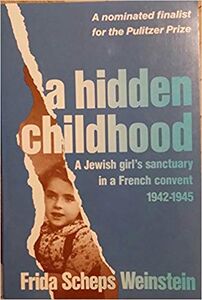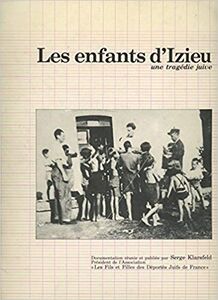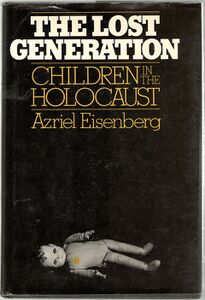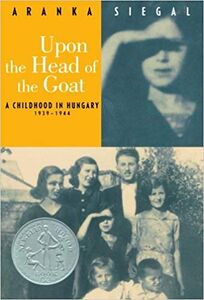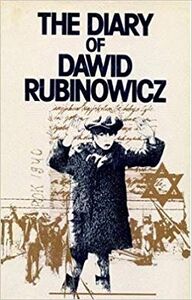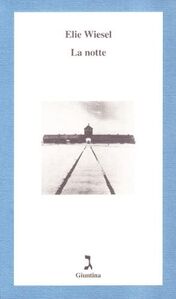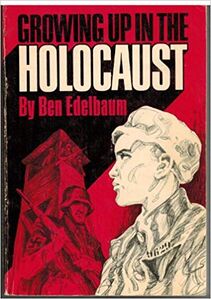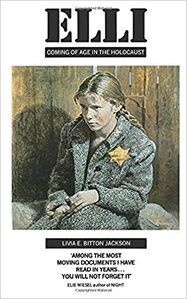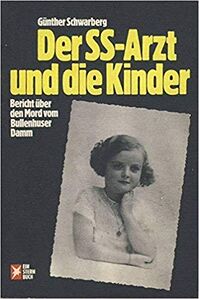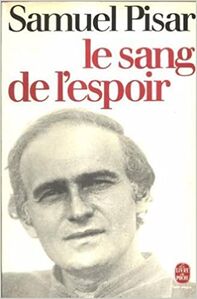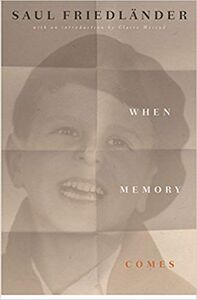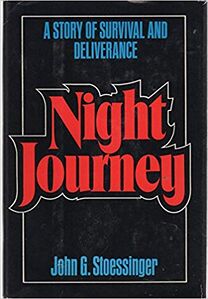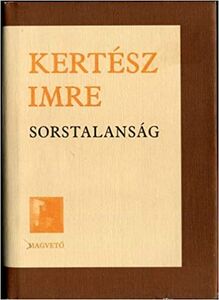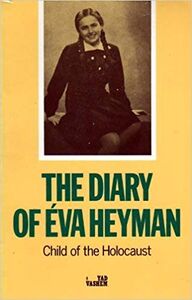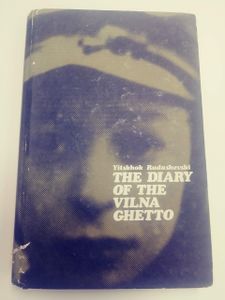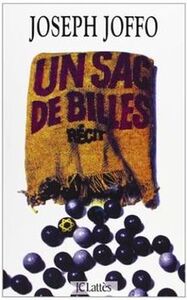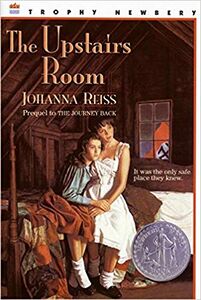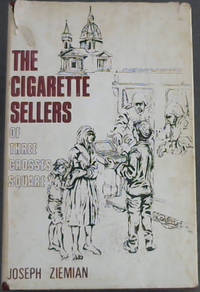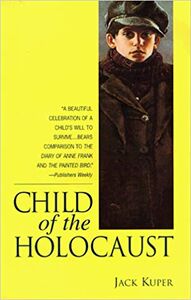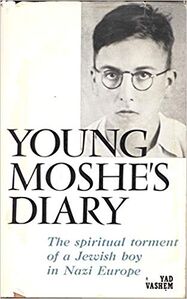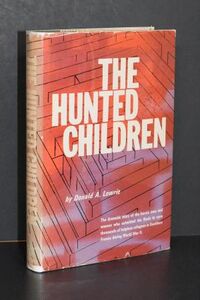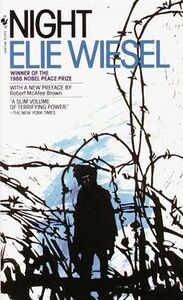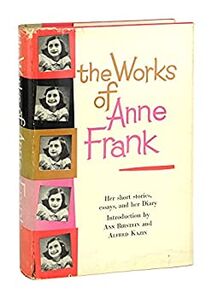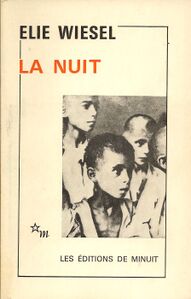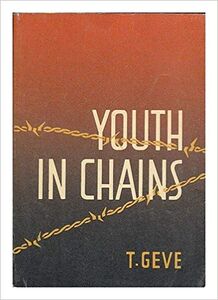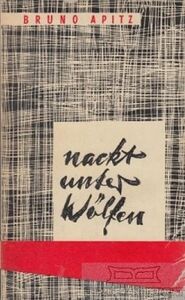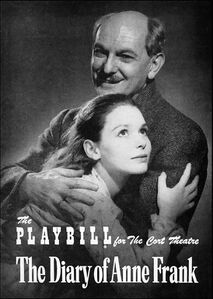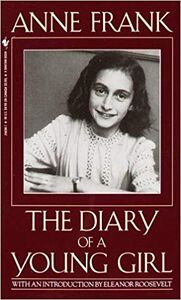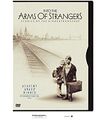Difference between revisions of "Category:Holocaust Children Studies"
(→1952) |
(→2010s) |
||
| Line 169: | Line 169: | ||
File:2010 Bailly English.jpg|Bailly (2010) en | File:2010 Bailly English.jpg|Bailly (2010) en | ||
</gallery> | </gallery> | ||
=== 2000s === | === 2000s === | ||
Revision as of 13:59, 22 March 2022
Overview
- See [[1]]
When World War II began in September 1939, there were approximately 1.6 million Jewish children living in the territories that the German armies or their allies would occupy. When the war in Europe ended in May 1945, more than 1.2 million and perhaps as many as 1.5 million Jewish children were dead, targeted victims in the Nazis’ calculated program of genocide. As Warsaw ghetto historian Emanuel Ringelblum wrote in 1942, “Even in the most barbaric times, a human spark glowed in the rudest heart, and children were spared. But the Hitlerian beast is quite different. It would devour the dearest of us, those who arouse the greatest compassion—our innocent children.”
All Jews were targeted for death, but the mortality rate for children was especially high. Only around 150,000, or 6 to 11% of Europe’s prewar Jewish population of children survived as compared with 33% of the adults. The majority of them were teenagers, between 16 and 18 years old. The younger generally were not selected for forced labor, and the Nazis often carried out “children’s actions” to reduce the number of “useless eaters” in the ghettos. In the camps, children, the elderly, and pregnant women routinely were sent to the gas chambers immediately after arrival. The older had a better chance of survival.
Liberation from Nazi tyranny brought no end to the sufferings of the few Jewish children who survived the Holocaust. Many would face the future without parents, grandparents, or siblings. Even when they were half-orphans, frequently surviving parents did not have the means or desire to care for their children.
The largest group of surviving children (60,000) was in Romania. There were 15,000 children alive in France; 12,000 in Hungary as well as in Bulgaria; 7,000 in Poland as well as in Italy; 4,000 in Belgium as well as in the Netherlands; between 2,500 and 4,500 in Czechoslovakia; 2,400 in Greece. A few thousand children survived in Concentration camps: 1,600 in Theresienstadt, 900 at Buchenwald, 500 at Bergen-Belsen, 300 at Auschwitz, etc. As many as 60,000 child survivors emigrated to the United States after the war.
Geography and Chronology of the Holocaust
(1) Racial Laws, Discrimination, Segregation (1933-38)
The first to be affected by the Holocaust were the Jewish children living in Germany. They were subjected to racial laws, discriminated, expelled from schools. Many of them left emigrated with their families.
Second came in 1938 the Jewish children living in Austria and Jewish children living in Czechia. They were subjected to the same restrictive measures as their companions in Germany. Racial laws were enacted in Italy and Hungary as well.
(2) Persecution (1938-1939 & beyond)
- Refugees -- Kindertransport -- Kraus Rescue Mission -- One Thousand Children -- Tehran Children -- Fort Ontario
Kristallnacht marked the beginning of a new, more violent stage in the persecution. In Germany, Austria and Czechia, synagogues were burned, properties were destroyed. People were arrested, intimidated, some even murdered. Emigration now became a race against time. Nearby countries (and even much far away countries, like China) became places of refuge. It was difficult however to obtain visas since many countries had strict immigration laws. Many children left alone in a Kindertransport in order to reach safety abroad.
(3) Ghettos, Hunger, Disease, Forced Labor (1939-41 & beyond)
In Sept 1939 Germany conquered Eastern Poland. Children living in Poland were immediately subjected to violent persecution, and eventually forced to live in overcrowded ghetto where thousands of them died of hunger and disease.
In May 1940, the Holocaust also hit children living in the Netherlands, Belgium and France. In occupied Western countries, Nazi authorities initially refrained from open violence in order not to provoke reactions from the local population. Racial laws were enacted and Jews were gradually deprived of any right and freedom. In occupied France and Italy, then an ally of the Germans, children of "foreign Jews" (even those born in Italy) were forced to live in internment camps.
(4) Extermination (1941-1945)
- Mass Shootings -- Death Camps -- Concentration Camps -- Hidden Children -- Street Children -- Partisans
The Operation Barbarossa marked the beginning of the most violent stage in the Holocaust. For the first time, children living in Eastern Poland, Russia, Ukraine, Belarus, Lithuania, Latvia and Estonia were directly targeted for extermination, first by specially appointed firing squads, then by deportation to death camps. By the beginning of 1942 death camps became fully operative. Jews were now deported from the Polish ghettos or from special transit camps in Western Europe directly to the gas chambers in Chelmno, Belzec, Treblinka, Sobibor, and Auschwitz. Children (especially orphans or the little ones) were the first ones to be murdered. (while only adolescents could have some chances as forced laborers).
After Sept 1943 the extermination was extended to Italy (now under German occupation) and following the German occupation of Hungary on 19 March 1944, also in Hungary.
(5) Liberation (1945)
Germany was losing the war. At the end of 1944-beginning 1945 the first concentration camps were liberated. Only a few children were found alive in Auschwitz on January 27, 1945. More consistent groups of children were liberated at Buchenwald, Berger-Belsen, Theresienstadt, Gunskirchen, ect. The end of the war also meant freedom for the thousands and thousands of children who were in hiding everywhere in Europe.
Many of the child survivors were now orphans or had been separated from their parents and relatives. Special DP camps were established for them in France, Italy (Selvino), Poland, Germany, the Netherlands...
Bibliography
2010s
- 2018 Berg.jpg
Berg (2018) repr <memoirs>
- 2017 Duguay.jpg
Duguay (2017) <film>
- 2016 German Zargani.jpg
Zargani (2016) de <@1975> <memoirs>
- 2016 Doillon.jpg
Doillon (2016) <film>
- 2015 Kadelbach.png
Kadelbach (2015) <film>
2000s
- 2007 French Zargani.jpg
Zargani (2007) fr <@1975> <memoirs>
- 2007 Berg.jpg
Berg (2007) <reprint>
- Fateless 2005.jpg
Koltai (2005) <film>
- 2004 Brenner.jpg
Brenner (2004)
- 2002 English Zargani.jpg
Zargani (2002) en <@1975> <memoirs>
1990s
- 1997 Benigni.jpg
Benigni (1997) <film>
- 1991 Durlacher.jpg
Durlacher (1991)
- 1990 Holland.jpg
Holland (1990) <film>
1998
- {en} Judith S. Kestenberg - Charlotte Kahn, eds. Children Surviving Persecution: An International Study of Trauma and Healing. Westport, CT: Praeger, 1998. --- "This international study of children's experiences of organized persecution, explores the Holocaust and its aftermath as prototypical social trauma. The essays in this collection focus on long-term effects of trauma caused by organized persecution - children's experiences of the horror and terror of war, and on the coping mechanisms and reparative experiences, which mitigate and sometimes surmount the trauma ... Traumatized persons' feelings of shame and guilt as well as a sense of being different may prevail, and they may attribute great power to others, seek safety in isolation, or search for a rescuer. Nevertheless, as a group, the child survivors of the Holocaust have achieved remarkable success as adults." --- Contents: Preliminaries; Contents; Preface; Introduction; 1 The Background of Persecution and Its Aftermath; 2 Historical Trauma Psychohistorical Reflections on the Holocaust; 3 Adult Survivors Child Survivors and Children of Survivors; 4 Man Behind Walls; 5 Interviewing for Indemnification; 6 Impact on the Second and Third Generations; 7 Antisemitism and Jewish Identity in Hungary Between 1989 and 1994; 8 Child Survivors A Review; 9 Nazi Fathers; 10 The Persecution of Polish Children; 11 Yugoslavian Child Survivors; 12 German Jewish Identity; 13 Kindertransport A Case Study --- Judith Ida Kestenberg (née Silberpfennig; 1910-1999) was a child psychiatrist who worked with Holocaust survivors. She founded the International Study of Organized Persecution of Children (ISOPC) an organization that coordinated the psychologically informed interviews of over 1500 child survivors throughout much of the world. Born in Poland to a Jewish family, she studied in Vienna. In 1937 she moved to the United States, where she spent her entire career.
1996
- {en} Judith S. Kestenberg - Ira Brenner. The Last Witness: The Child Survivor of the Holocaust. American Psychiatric Press, 1996). --- "The Last Witness: The Child Survivor of the Holocaust looks in depth at the traumatic effects of genocidal persecution on the child's psychic structure and on development through the life cycle. It offers valuable information to clinicians working with Holocaust survivors and their families and serves as an indispensable guide for therapists and interested readers who want to learn more about the short- and long-term effects of genocidal persecution ... The authors have combined their findings, based on more than 1,500 interviews with Holocaust survivors from all over the world, to create this volume. Through case vignettes and life histories, the book offers historical information on the Holocaust itself, the overall plight of children superego development, and the role often played by transitional phenomena in mastering the attendant trauma and object loss. Special attention is paid to the effects of the Holocaust on children who were in hiding and the experience of adolescent children, as described in the diary of an adolescent girl ... Anyone who reads this book will have a greater understanding of how the developing child can be affected by trauma associated with persecution. It is one of very few books written about the psyches of survivors and their children. As a forum for survivors' voices, it will endure as a somber reminder that the future of humankind hangs in the balance between the forces of creation and the forces of destruction." --- Judith Ida Kestenberg (née Silberpfennig; 1910-1999) was a child psychiatrist who worked with Holocaust survivors. She founded the International Study of Organized Persecution of Children (ISOPC) an organization that coordinated the psychologically informed interviews of over 1500 child survivors throughout much of the world. Born in Poland to a Jewish family, she studied in Vienna. In 1937 she moved to the United States, where she spent her entire career.
1995
- {it} Aldo Zargani. Per violino solo: La mia infanzia nell'Aldiqua, 1938-1945. Bologna: Il Mulino, 1995. --- <Holocaust> <Memoirs> --- "In an extraordinary literary debut, Aldo Zargani reconstructs the lost world of his Jewish childhood during the perilous years 1938–45 when he and his family fled from Fascists and Nazis in northern Italy. His haunting memoir acquires a cinematic intensity as he crosscuts from the blood-red stone spires of Basel, where his father failed to find refuge for his family in 1939, to fiery scenes of the Allied bombing of Turin in 1942, to the freezing winter of 1943–44, which Zargani and his brother spent hidden in a Catholic boarding school deep in the countryside."
- {fr} Le mémorial des enfants juifs déportés de France (French children of the Holocaust / 1995, 1996.
1994
- {it} Lia Levi. Una bambina e basta. Roma [Italy]: E/O, [1994] --- <Holocaust> <Memoirs> --- "Lia ha appena finito la prima elementare, quando la mamma le dice che a settembre non potrà più tornare in classe. Mussolini, che comanda su tutti, non vuole più i bambini ebrei nelle scuole. In realtà non vuole gli ebrei a Torino, dove Lia abita con la famiglia, né a Milano e nemmeno a Roma. Non li vuole da nessuna parte. Con le valigie sempre in mano, i perché nella testa di Lia crescono ogni giorno. Perché il papà ha perso il lavoro? Cosa importa a Mussolini se alcuni bambini vanno a scuola e altri no? Perché la tata Maria non può più stare con loro? Perché non può essere solo una bambina, una bambina e basta? Età di lettura: da 6 anni."
- {en} Maxine B. Rosenberg. Hiding to Survive: Stories of Jewish Children Rescued from the Holocaust. New York, NY: Clarion Books, 1994. --- Nonfiction <juvenile audience>. --- "The first-person stories of fourteen Jewish children who were hidden, during World War II, from the Nazis by non-Jewish friends--in monasteries, convents, secret closets, chicken coops, and elsewhere--are accompanied by information on what those children are doing today." --- Contents: Paulette Pomerantz -- Kurt Dattner -- Rose Silberberg-Skier -- Manny Stern -- Cécile Rojer Jeruchim -- Jacques van Dam -- Sylvia Richter -- Andy Sterling -- Hirsch Grunstein -- Aviva Blumberg -- Ruth Bachner -- Debora Biron -- Simon Jeruchim -- Judith Steel. --- Maxine B. Rosenberg is a published author of children's books and young adult books.
- {en} Judith S. Kestenberg - Eva Fogelman, eds. Children During the Nazi Reign: Psychological Perspective on the Interview Process. Greenwood, 1994. --- "This work shows how interviews help child survivors of the Jewish experience during World War II. It is unique in that it features different aspects of the interviewer-interviewee relationship. The contributions are personal as well as analytical in nature, and the narrative is an informed psychological analysis. The work should be of interest to Holocaust centers, researchers, oral historians, psychiatrists, psychologists, social workers, sociologists, and trauma researchers as well as survivors." --- Judith Ida Kestenberg (née Silberpfennig; 1910-1999) was a child psychiatrist who worked with Holocaust survivors. She founded the International Study of Organized Persecution of Children (ISOPC) an organization that coordinated the psychologically informed interviews of over 1500 child survivors throughout much of the world. Born in Poland to a Jewish family, she studied in Vienna. In 1937 she moved to the United States, where she spent her entire career. --- Eva Fogelman was born in a displaced persons camp in Kassel, Germany after World War II. She lived in Israel for a brief period before coming to the United States in 1959, where she pursued her career as a psychologist.
- {en} Richard C. Lukas. Did the Children Cry?: Hitler's War Against Jewish and Polish Children (New York, NY: Hippocrene Books, 1994). --- "An unprecedented aspect of Nazi genocide in World War II was the cold and deliberate decision not to spare the children. Jewish children, first driven into the ghettos, were marked for total destruction as part of the "Final Solution" once it was put into effect, in 1942. Gentile children were starved, killed, or Germanized in order to reduce the Polish nation to a small complement of semi-literate slaves tending the Herrenvolk in their thousand-year Reich. This record also includes accounts of how they fought back by working for the underground, smuggling food into the ghettos, attending secret classes to continue their forbidden education. Included are stories of villains like Mengele who selected children for execution during Jewish religious holidays; Rudolph Hoess, Auschwitz's commandant who admitted his own discomfort when he witnessed the gassing of prisoners with the excuse: "I was a soldier and an officer"; a heroic Dr. Janusz Korczak who was in charge of an orphanage in the ghetto, but refused to leave his orphans, and at the head of a contingent of 192 children and 8 staff members, erect, his eyes looking into the distance, held the hands of two children as he led them to the railroad platform where trains took them to certain death. Based on vast research in the United States, Great Britain, and Poland, many interviews, theses and other papers, documents and official histories, memoirs, autobiographies, articles, periodicals and newspapers, Did the Children Cry? stands as a monument to millions of children who were bombed, wounded, deported, raped, starved, maimed, subjected to "medical" experimentation, and killed in German-occupied Poland."--Publisher description. --- Richard C. Lukas (b.1937) is an American historian and author of books and articles on military, diplomatic, Polish, and Polish-American history. He specializes in the history of Poland during World War II.
- {en} Ota B. Kraus. The Painted Wall / The Children's Block (Tel-Aviv : Yaron Golan Publ., 1994). Repr. London: Ebury Press, 2019. Also translated into German (2002). --- A semi-fictional account, based on his own personal experience. --- "In the novel The Painted Wall, Otto (Ota) B. Kraus writes about his own experience in Auschwitz during WWII. Otto was one of the instructors in the children's block and his (future) wife Dita, was the librarian for the children, of whom only a handfull survived. The book, which was originally named "The Diary", was written after the war. The story of a diary is but a literary introduction, yet the events described in the book are real. The Painted Wall tells the true story of 500 Jewish children who lived in the Czech Family Camp in Auschwitz-Birkenau between September 1943 and June 1944. The children were kept on a Children's Block supervised by the notorious Dr. Mengele, where their instructors organized clandestine lessons, singalongs and even staged little plays and charades. The Children's Block was intended to provide the Nazis with an alibi to refute the rumors of the Final Solution. As long as the Children's Block existed, it was a shelter and haven for the hundreds of children, who soon afterwards perished in the gas chambers." --- Ota "Otto" B. Kraus (1921-2000) was born and raised in Prague to a Jewish family. In May 1942 he was confined with his family to Ghetto Terezin . In December 1943 he was deported to Auschwitz, where at the time the Nazis had established a special family camps for those arriving from Terezin. Otto became one of the children’s counselors on the Kinderblock, a special barracks where the children were kept during the day. After a few months the camp was liquidated and the inmates were almost all sent to the gas chambers. Otto was one of the few selected to survive as labor force. A fervent Zionist, after the war he settled to Israel, where he was a teacher and writer.
1993
- {en} Paul Valent. Child Survivors of the Holocaust (Port Melbourne : William Heinemann Australia, 1993). Repr. New York, NY: Brunner-Routledge, 2002. --- "How can the abused child remember the events of childhood? What help does our society offer our traumatised children? With an unreliable memory inhibited by frightening feelings and a society keen to repress its own responsibility, the traumatised child is left alone and unsupported. At the end of the Second World War it was estimated that 1.5 million Jewish childred had been killed by the Nazis. In this book ten child survivors tell their stories. Their experiences range from living in hiding to physical and sexual abuse. Safe from neither the supposed protector nor the obvious enemy, these children's stories are remarkable. From these unchildlike childhoods we learn about courage and fortitude, and we respond with admiration and compassion. The testimonies in Child Survivors offer insights into our own pasts and give us all greater courage ... In this book, ten child survivors tell their stories. Paul Valent, himself a child survivor and psychiatrist, explores with profound analytical insight the deepest memories of those survivors he interviewed. Their experiences range from living in hiding to physical and sexual abuse. Child Survivors of the Holocaust preserves and integrates the personal narratives and the therapist's perspective in an amazing chronicle. The stories in this book contribute to questions concerning the roots of morality, memory, resilience, and specifc scientific queries of the origins of psychosomatic symptoms, psychiatric illness, and trans-generational transmission of trauma. Child Survivors of the Holocaust speaks to the trauma facing contemporary child victims of abuse worldwide through past narratives of the Holocaust ... The survivors are: Eva Slonim, who was subject to experiments by Mengele in Auschwitz; Bernadette Szkop Gore and her sister Frankie Paper, who were hidden in Paris; Richard Rozen (born Rozencwajg), who was in the Lublin ghetto; Juliette Zeelander, who survived in Amsterdam; Eva Steiner Grant, who was in Theresienstadt, as was George Hammerschmidt, after living in Zwickau and Berlin; Eva Marks, who fled from Vienna to Riga, and then to the USSR; Danial Kogan, whose father and siblings were deported from France to Auschwitz; and an anonymous woman who was abused, including sexually, by members of several families that hid her in France during the Holocaust." --- Paul Valent is a child survivor of the Holocaust who spent the war in open hiding in Budapest, Hungary. He migrated with his parents to Melbourne, Australia in 1949. After studying medicine he received a postgraduate psychiatric degree in London, and then worked in Israel for three years. Back in Australia he specialized in liaison psychiatry (mainly in emergency departments), in psychotherapy and in traumatology. He co-founded and is ex-president of the Australasian Society for Traumatic Stress Studies and he founded and is ex-president of the Melbourne Child Survivors of the Holocaust group.
- {it} Emanuele Pacifici. «Non ti voltare». Autobiografia di un ebreo. Firenze [Italy]: Giuntina, 1993). --- "Le memorie di Emanuele appartengono alle testimonianze rese da quanti, come anche Aldo Zargani, dichiarano esplicitamente di scrivere a distanza di tempo e manifestano la volontà di parlare per onorare la memoria sia dei loro morti sia di tutte le vittime della Shoah, e soprattutto perché i giovani e le generazioni future facciano tesoro delle vicende narrate e ne tramandino il ricordo ... Emanuele, nato nel 1931, viene nascosto in un convento e sopravvive alla guerra. Nel suo racconto si intrecciano drammi personali – l’allontanamento da casa dopo la morte di una sorellina in un incidente domestico e la nascita del fratellino Raffaele – e il dramma storico della Shoah, che il bambino vive in un istituto religioso dove è nascosto con il fratello, sotto falsa identità. La fede lo aiuta sia a mantenere segreta la sua origine ebraica, sia a non lasciarsi attrarre dal cattolicesimo per riconoscenza o desiderio di appartenenza ... La liberazione, dopo l’emozionante incontro con un soldato della Brigata Ebraica, assume nel suo racconto toni particolarmente dolorosi da un lato con l’arrivo a Roma e la scoperta che tanti parenti, compresi i genitori, non ci sono più, dall’altro con gravi problemi di salute che gli impediscono di partire alla volta di Eretz Israel, il futuro Stato ebraico."
- {en} Jane Marks. The Hidden Children: The Secret Survivors of the Holocaust (New York : Ballantine Books, 1993). --- "They hid wherever they could for as long as it took the Allies to win the war--Jewish children, frightened, alone, often separated from their families. For months, even years, they faced the constant danger of discovery, fabricating new identities at a young age, sacrificing their childhoods to save their lives. These secret survivors have suppressed these painful memories for decades. Now, in The Hidden Children, twenty-three adult survivors share their moving wartime experiences -- some for the first time ... There is Rosa, who hid in an impoverished one-room farmhouse with three others, sleeping on a clay pallet behind a stove; Renee, who posed as a Catholic and was kept in a convent by nuns who knew her secret; and Richard, who lived in a closet with his family for thirteen months. Their personal stories of belief and determination give a voice, at last, to the forgotten. Inspiring and life-affirming, The Hidden Children is an unparalleled document of witness, discovery, and the miracle of human courage." --- Jane Marks is an American author and journalist whose article in New York magazine became the basis for her book on children who survived the Holocaust in hiding.
1991
- {en} Deborah Dwork. Children with a Star: Jewish Youth in Nazi Europe (New Haven, CT: Yale University Press, 1991). --- Translated into German (1994), Italian (1994), Dutch (1998), and Japanese (1999). --- "Based on many oral histories taken from child survivors of the Holocaust, the author focuses on the experiences of young Jewish children from their earliest encounters with anti-Semitism to their enslavement in labor camps ... Many books have been written about the experiences of Jews in Nazi Europe. None, however, has focused on the persecution of the most vulnerable members of the Jewish community―its children. This powerful and moving book by Deborah Dwork relates the history of these children for the first time ... The book is based on hundreds of oral histories conducted with survivors who were children in the Holocaust, in Europe and North America, an extraordinary range of primary documentation uncovered by the author (including diaries, letters, photographs and family albums), and archival records. Drawing on these sources, Dwork reveals the feelings, daily activities, and perceptions of Jewish children who lived and died in the shadow of the Holocaust. She reconstructs and analyzes the many different experiences the children faced. In the early years of Nazi domination they lived at home, increasingly opposed by rising anti-Semitism. Later some went into hiding while others attempted to live openly on gentile papers. As time passed, increasing numbers were forced into transit camps, ghettos, and death and slave labor camps. Although nearly ninety percent of the Jewish children in Nazi Europe were murdered, we learn in this history not of their deaths but of the circumstances of their lives ... Children with a Star is a major new contribution to the history of Europe during the Nazi era. It explains from a different perspective how European society functioned during the wary years, how the German noose tightened, and how the Jewish victims and their gentile neighbors responded. It expands the definition of resistance by examining the history of the people―primarily women―who helped Jewish children during the war. By focusing on children, it strips away rationalizations that the victims of Nazism somehow “allowed or “deserved” their punishment. And by examining the experience of children and thereby laying bare how society functions at its most fundamental level, it not only provides a unique understanding of the Holocaust but a new theoretical approach to the study of history." --- Deborah Dwork is Senior Research Scholar, Strassler Center for Holocaust and Genocide Studies and Department of History, Clark University, Worcester, MA. Dwork moved from the history of childhood as a social construct to the history of children as subjects and actors. Her historical analysis used children’s experiences as a lens through which to view all of society.
- Gerhard Durlacher. De zoektocht <Dutch> (Amsterdam : Meulenhoff, 1991). --- English ed. The Search: The Birkenau Boys, trans. Susan Massotty (London ; New York : Serpent's Tail, 1998). --- Also translated into German (Die Suche : Bericht über den Tod und das Uberleben, Hamburg: Europäische Verlagsanstalt, 1995). --- "Gerhard Durlacher was stunned to discover that he was not the only survivor who was assigned to Auschwitz-Birkenau in 1944. The Search follows his quest to find his fellow survivors and ends with a reunion of the Birkenau boys in Israel in 1990 ... A child survivor of the Holocaust, Durlacher long believed that he was the only person still alive from a group of 89 boys assigned to the Birkenau extermination camp in 1944. After he learned that he was wrong, he set himself the task of confronting his past by locating some of the others. As in many other Holocaust memoirs, the prose here is spare, and the lack of detail can be a little confusing. For example, the reader is thrown into the author's search without a description of the process that led him to take his journey. But some psychological truisms emerge in this gray travelogue that, while not fresh, are worth ruminating over. What the author, a professor of sociology at the University of Amsterdam who died in 1996, finds is that even though the survivors shared a common experience, how they have coped with their wartime suffering differs. Some, in particular those who have moved to Israel, meet regularly with other survivors; others keep their harrowing past buried deep in their psyches. Equally diverse are survivors' personal outlooks--despite what they have gone through, some of the "Birkenau Boys" still call themselves optimists, while others possess the bitterness one would expect. Not surprisingly, Durlacher, who wrote two previous books on the Holocaust, enjoyed the company of the former much more than the latter."--Publisher description. --- Gerhard Durlacher (1928-1996) was a Holocaust child survivor and writer.
- {en} Martin Gilbert. The Boys: Triumph over Adversity (London: Weidenfeld & Nicolson, 1991). --- "The story of 732 young concentration camp survivors ... In August 1945, Britain offered to take in 1,000 young survivors [of the Holocaust]. Only 732 could be found. Flown to England, they first settled in the Lake District. They formed a tightly knit group of friends whose terrible shared experience is almost beyond imagining. This is their story, which begins in the lost communities of pre-World War II central Europe, moves through ghetto, concentration camp and death march, to liberation, survival, and finally, fifty years later, a deeply moving reunion ... After sharing their annual reunions for twenty years with historian Martin Gilbert, the men and women of "The Boys" asked him to share their recollections and experiences ... The Boys bears witness to the human spirit, enduring the depths, and bearing hopefully the burden and challenge of survival." --- Martin Gilbert (1936-2015) was a British historian and honorary Fellow of Merton College, University of Oxford. He was the author of eighty-eight books, including works on Winston Churchill, the 20th century, and Jewish history including the Holocaust.
1990
- {en} Lucette Lagnado - Sheila Cohn Dekel. Children of the Flames: Dr. Josef Mengele and the Untold Story of the Twins of Auschwitz. New York, NY: Morrow, 1990). --- "During World War II, Nazi doctor Josef Mengele subjected some 3,000 twins to medical experiments of unspeakable horror; only 160 survived. In this remarkable narrative, the life of Auschwitz's Angel of Death is told in counterpoint to the lives of the survivor twins, who until now have kept silent about their heinous death-camp ordeals and are themselves now inching into middle or old age. In stories that abound with ambiguity, anger, and redemptive hope, we encounter them first as children beginning their descent into Auschwitz by witnessing their entire families being led away to be killed. Later, we see the twins grateful for the soup and bread Mengele procured for them and reassured by his moments of seemingly genuine affection, yet terrified, always, by what he forced them to endure." ---- Lucette Matalon Lagnado (USA, 1956-2019) was an Egyptian-born American Jewish journalist and memoirist. Born in Cairo to a Jewish family, she lived in the United States. She was a reporter for The Wall Street Journal.
1980s
- 1987 Sherin.jpg
Sherin (1987) <film>
- 1987 Malle.jpg
Malle (1987) <film>
- 1985 Klarsfeld English.jpg
Klarsfeld.en (1985) [1984]
- 1984 Schwarberg English.jpg
Schwarberg.en (1984) <1979>
- 1984 Orlev.jpg
Orlev.en (1984) <1981>
- 1984 Hemmendinger.jpg
Hemmendinger (1984)
1988
- George Eisen. Children and Play in the Holocaust: Games among the Shadows (Amherst, MA: University of Massachusetts Press, 1988). --- "Studies the importance of "playing" to the survival of children in Nazi organized ghettos and concentration camps. illustrates how the feeling of normalcy created through play, provided not only a means of control by adults ... But a psychological Force which allowed for spiritual survival. examines the nature of games played, emphasizing how games such as "blockade" and "gas Chamber" reflected the environment in which they were created and played."--Publisher description. --- George Eisen (b.1943) was born in German-occupied Hungary. As a little child he spent a year in hiding with his Jewish mother while his father was held prisoner in a concentration camp. He attended high school in Hungary, college in Israel and received a doctorate from the University of Maryland. He has taught in Cal Poly Pomona’s physical education department since 1979. He got the idea for his book while researching organized Jewish sports in pre-World War II Europe for his doctorate.
- Betty Jean Lifton. The King of Children: A Biography of Janusz Korczak (New York, NY: Farrar, Straus and Giroux, 1988). --- "A detailed biography of Janusz Korczak (1878-1942) - doctor, teacher, writer and educational theorist - who was deported along with the children of his orphanage in August 1942 from the Warsaw ghetto to Treblinka, where they perished ... This is the tragic story of Janusz Korczak (as featured in the major motion picture The Zookeeper's Wife) who chose to perish in Treblinka rather than abandon the Jewish orphans in his care. Korczak comes alive in this acclaimed biography by Betty Jean Lifton as the first known advocate of children's rights in Poland, and the man known as a savior of hundreds of orphans in the Warsaw ghetto. A pediatrician, educator, and Polish Jew, Janusz Korczak introduced progressive orphanages, serving both Jewish and Catholic children, in Warsaw. Determined to shield children from the injustices of the adult world, he built orphanages into 'just communities' complete with parliaments and courts. Korczak also founded the first national children's newspaper, testified on behalf of children in juvenile courts, and, through his writings, provided teachers and parents with a moral education. Known throughout Europe as a Pied Piper of destitute children prior to the onslaught of World War II, he assumed legendary status when on August 6, 1942, after refusing offers for his own safety, he defiantly led the orphans under his care in the Warsaw Ghetto to the trains that would take them to Treblinka." --- Betty Jean Lifton (USA, 1926-2010) was an adopted child. For entire career as a psychologist, she kept a clear and present focus on children, on children’s issues, and on children’s literature. She authored several books on adoption.
1984
- Serge Klarsfeld. Les enfants d'Izieu (Paris [France]: B. Klarsfeld Foundation, 1984) <French>. --- English tr. The Children of Izieu (New York, NY: H. Abrams, 1985). --- "Presents the story of an orphanage in Izieu, France that sheltered Jewish children from all over Europe who had escaped Nazi persecution. In 1944, one month before World War II ended, the Gestapo sent soldiers to the orphanage to arrest all the children and caretakers. Those arrested were taken to Auschwitz for immediate execution. The events are recounted through the stories of those who escaped the Nazi raid." --- Serge Klarsfeld (b.1935) is a Holocaust child survivor, a Romanian-born French activist and Nazi hunter known for documenting the Holocaust in order to establish the record and to enable the prosecution of war criminals. Born in Bucharest into a family of Romanian Jews, they migrated to France before the Second World War began. Serge's father was deported and killed during the Holocaust. Serge was cared for in a home for Jewish children operated by the OSE (Œuvre de secours aux enfants). His mother and sister also survived the war in hiding in France. In 1979 Serge helped found and has ever since led the Sons and Daughters of Jewish Deportees from France (Association des fils et filles des déportés juifs de France).
- Judith Hemmendinger. Les enfants de Buchenwald: que sont devenus les 1000 enfants juifs sauvés en 1945? (Lausanne, Suisse : P.-M. Favre, 1984). --- The Children of Buchenwald : Child Survivors and Their Post-War Lives, English rev. ed. by Judith Hemmendinger and Robert Krell (Jerusalem ; Hewlett, NY. : Gefen House, 2000). --- Also translated into German. --- Some of the 426 child survivors of Buchenwald tell their stories, from their lives in the camp, their liberation, and their struggle for normalcy and emotional well-being. --- Contents: From Auschwitz to Liberation - Arrival in France - The children at Ambloy - Lulek's story -- Romek's story - Taverny -- Destinations: leaving Taverny - Life journeys: 20 years later in New York - Life journeys: France - Life journeys: Israel - Elie Wiesel - Observations and conclusions.
1982
- Azriel Eisenberg. The Lost Generation: Children in the Holocaust (New York : Pilgrim Press, 1982). Gabriele Boccaccini (talk) "Collects firsthand accounts of the Nazi persecution of Jewish children during World War II and the efforts of the members of the organization, Youth Aliyah, to rescue these children ... Explores the wide range of experiences suffered by children during the Holocaust, including their lives in the Nazi ghettos and concentration camps, as well as years spent hiding in the forests ... Passing as Aryans, or living under the protection of righteous gentiles. chapters 6 and 7 explore children's diaries, including Anne Frank's, and written testimonies by children." Gabriele Boccaccini (talk) Azriel Eisenberg (USA, 1903-1985). The child of Jewish immigrants, Eisenberg devoted his entire life to the cause of Jewish education. His interests led him to revisit the experience of children during the Holocaust. After the anthologies of the 1940s, his book was the first collection of children's accounts of the Holocaust.
1981
- The Diary of Dawid Rubinowicz (Edinburgh, Scotland: Blackwood, 1981) is the first English edition of a diary written in Polish by Holocaust victim Dawid Rubinowicz (1927-1942) in 1940-42 (age 12-15), while living in Poland under Nazi rule. First published in Poland (Warszawa : Ksiazka i Wiedza, 1960). Also published in German, Hungarian, Hebrew, French, Dutch, Italian, Japanese, Slovak, Spanish, Swedish, Ukrainian, Norwegian, Danish, Russian, Yiddish. --- "Dawid Rubinowicz began his diary in March 1940, after the Nazi invasion, and continued until at least June 1942. He left his diary, written in at least five copybooks, with his Polish neighbor and friend, Tadeusz Waciński. Later, the notebooks were passed on to Antoni Waciński, who kept them in his house for 15 years. A family that rented the house in the 1950s found the diary and read it aloud on the local radio. A few years later, journalist Maria Jarochowska arranged for it to be published for the first time. Excerpts from Dawid's diary also appear in several anthologies, including Salvaged Pages: Young Writers’ Diaries of the Holocaust, edited by Alexandra Zapruder and We Are Witnesses: Five Diaries of Teenagers Who Died in the Holocaust, edited by Jacob Boas." ---"Presents the diaries of a twelve-year-old Polish boy written between 1940 and 1942. Describes the Nazi occupation of Poland and the increasingly harsh decrees targeting Jews. Contains photographs" (USHMM). --- Dawid Rubinowicz (1927-1942) was born and raised in Krajno, Poland, the son of a poor Jewish diary farmer. Dawid and his entire family perished in the Nazi gas chambers at Treblinka. Dawid was only 15 when he died.
1970s
- Oberski Dutch.jpg
Oberski (1978) <memoirs>
1979
- Günther Schwarberg. Der SS-Arzt und die Kinder: Bericht über den Mord vom Bullenhuser Damm <German> (Hamburg [Germany]: Gruner und Jahr, 1979). -- English tr. by Henri Nannen. The Murders at Bullenhuser Damm: The SS Doctor and the Children (Bloomington: Indiana University Press, 1984). --- "On the night of April 20, 1945, 20 Jewish children who had been used in medical experiments at Neuengamme, their four adult caretakers and six Soviet prisoners were murdered in the basement of the school ... The twenty Jewish children (10 boys and 10 girls, age 5 to 12, from Poland, France, Italy and Slovenia) came from Auschwitz concentration camp. They were chosen by Josef Mengele and sent to Neuengamme as a "gift" to his colleague Kurt Heissmeyer, to be used as guinea pigs for experiments on tuberculosis". --- Günther Schwarberg (1926-2008) was a German journalist and author whose 1979 series of articles in German news magazine Der Stern and subsequent book "The SS Doctor and the Children" brought the World War II era war crimes committed in Neuengamme concentration camp and Bullenhuser Damm School in Hamburg to the public's conscience in Germany, and the rest of the world.
1974
- The Diary of Éva Heyman (1974) is the first English edition of a diary written by Holocaust victim Éva Heyman (1931-1944) in 1944 (age 13), while living in Hungary under Nazi rule. Published in Jerusalem: Yad Vashem, 1974. Originally published in Budapest: Uj Idok Irodalmi Intézet R.T. (Singer és Wolfner), 1948. Also published in Hebrew, Catalan, French and Italian. --- "The diary of Éva Heyman, born in 1931 in Nagyvárad, northern Transylvania (now Oradea, Romania), presented by her mother, Ágnes Zsolt. Her diary covers the period from 13 February (her 13th birthday) to 30 May 1944. At the time of the German occupation in March 1944, Éva was a student at the Jewish school. Her great-grandfather and a great-uncle had been Chief Rabbis of the Neolog Jewish community in the town in the 19th-20th centuries. Éva's parents had divorced, and her mother married the Hungarian Jewish writer Béla Zsolt, who lived in Budapest; Éva remained in Nagyvárad and was raised by her maternal grandparents, the Rácz family. In her diary, she gives a graphic description of the harsh events of the time, both in her home environment and in the city at large. When the ghetto was established in Nagyvárad, Éva's parents, who had been visiting in Nagyvárad, were also interned. They managed to escape from the ghetto to Budapest, where they were rescued on the Kasztner train. Éva, her grandparents, her biological father (Béla Heyman), his mother, as well as other family members were all deported to Auschwitz. Éva arrived in Auschwitz on 6 June, and was gassed on 17 October. Her mother presents here a very brief but heartrending description of Éva's experiences in Auschwitz. At the end, it was Mengele himself who sought her out and put her on the truck to be taken to the gas chamber. Her diary survived because she gave it to the family's cook who came to visit them in the ghetto on 30 May." --- "Presents diary entries from the last few months of a young girl’s life, from her thirteenth birthday on February 13, 1944 to May 30, 1944, just before she was deported to Auschwitz. Conveys her fears and describes daily life in a ghetto in Nagyvarad, Romania. Includes endnotes and an appendix of letters written to her mother about Eva from people close to the family" (USHMM).
1973
- The Diary of the Vilna Ghetto (1973) is a diary written by Holocaust victim Yitskhok Rudashevski (1927-1943) in the years 1941-43 (age 14-16), when living in the Vilma Ghetto. Originally published in Hebrew in 1968. --- Published in Tel Aviv [Israel]: Ghetto Fighters' House, 1973. Originally published in Hebrew (Tel Aviv: ha-Kibuts ha-meuhad, 1968). Also published in French (2016), and Lithuanian/Yiddish (2018). --- Yitskhok Rudashevski wrote a diary from June 1941 to April 1943 which detailed his life and struggles living in the Vilna ghetto. His diary was discovered by his cousin Sore Voloshin, in 1944. His cousin Voloshin fought the German army and the Soviet Union, later returning to the hideout, and found Yitskhok's diary. The diary was published in 1973 in English translation by the Ghetto Fighters' House publisher in Israel. --- "This is the diary of one of the "other Anne Franks," teen diarists of the Holocaust who are not nearly as famous as she. Yitskhok Rudashevski was fourteen when he began his diary in Vilna (Vilnius), Lithuania during the Nazi occupation. He was a gifted writer and wrote movingly of how his family and all the other Vilna Jews were confined to a ghetto and the ghetto kept shrinking and shrinking as the Nazis conducted "Aktions" and killed vast numbers of people, usually by machine-gunning them en masse at nearby Ponar. Rudashevski did not survive; he and his family went into hiding, but they were caught and almost all of them were executed. He was fifteen years old when he died. His account of the suffering of the Vilna Jews, and his own struggle to remain human amid the disaster, is well worth reading." --- "Diary of a boy who died during the liquidation of the Vilna ghetto. Records events occurring in the ghetto and his activities with Rudashevski’s school and youth club. Contains endnotes and appendixes including a testimony by the author’s cousin describing her discovery of the diary."--Holocaust Encyclopedia (USHMM). --- Yitskhok Rudashevski (1927-1943) was a young Jewish teenager who lived in the Vilna Ghetto in Lithuania during the 1940s. He was shot to death in the Ponary massacre on Oct 1, 1943 during the liquidation of September–October 1943.
1970
- Joseph Ziemian. The Cigarette Sellers of Three Crosses Square. Minneapolis: Lerner Publications Co., 1970). --- "The Cigarette Sellers of Three Crosses Square is the true account of a band of Jewish children, ages seven to sixteen, who survived the Warsaw Ghetto during the last three years of World War II (1943-1945). The author, Joseph Ziemien, finds two of the children by accident at a soup kitchen in Central Warsaw ... The astonishing, true story of a group of Jewish children who managed to escape from the Warsaw ghetto in 1942 and survive in the Aryan section of the Nazi-occupied city. Sentenced to death, hounded at every step, they kept themselves alive by peddling cigarettes in Warsaw's Three Crosses Square - where the author, a member of the Jewish Underground in Poland, met and helped them and recorded their story. Several of the children were finally caught and killed, but most survived and are alive today. The story of the cigarette sellers has been published in Polish, Romanian, Hebrew and Yiddish, and a dramatised version has been broadcast in Israel. The book was awarded a literary prize by the World Jewish Congress in New York."
1960s
- 1967 Berri.jpg
Berri (1967) <film>
- 1965b Kosinski.jpg
Kosinski (1965)
- 1963 Beyer.jpg
Film (1963)
- 1948 Lena.jpg
Küchler-Silberman (1961) en]]
- 1960 Leopold.jpg
Leopold (1960) <film>
1965
- Young Moshe's Diary: The Spiritual Torment of a Jewish Boy in Nazi Europe (1965) is the English ed. of a diary written by Holocaust victim Moshe Flinker (1926-1944) in the years 1942-1943 (age 15-17), when living in hiding in Brussels, Belgium with his family. --- "Moshe Flinker died in Auschwitz but he left copy books describing his innermost thoughts during the fateful days prior to his deportation. His surviving sisters rescued his writings from the cellar of the house in which they had all hid. In his unnatural underground existence he did not fully realize the methodical extermination being perpetrated by the Nazis, but he came very near in a remarkable portrayal of the Jewish situation, which he recorded in January 1943."--Publisher description. --- "Diary of a Belgian teenage boy who died with his parents in Auschwitz. Focuses on his strong identification with the rest of the Jewish community and his feelings of guilt for living safely with his family."--Holocaust Encyclopedia (USHMM). --- "Moshe Flinker was a sixteen-year-old Jewish boy whose family had fled from Holland to Belgium in an attempt to avoid deportation to the east. During this period of hiding and flight, Moshe was no longer able to go to school or to engage in the activities of normal life. In an attempt to stave off idleness, he decided to begin a diary. Moshe used his diary to record the experiences that his family faced in their struggle to endure Nazi persecution. He also wrestled continuously with the question of why this suffering plagued the Jewish people. On November 30, 1942 he wrote, “Now I return to the question mentioned above and its solution: what can God mean by all that is befalling us and by not preventing it from happening? This raises a further question, which must be settled before we can proceed further with the main problem. This second question is whether our distress is part of the anguish that has afflicted the Jewish people since the exile, or whether this is different than all that has occurred in the past. I incline to the second answer, for I find it very hard to believe that what we are going through today is only a mere link in a long chain of suffering.” Moshe was a deeply religious young man and he sought to understand his present circumstances in the light of biblical history. He looked for insight from the persecutions of the past and longed for God’s promised redemption of the Jewish people. He believed that this deliverance would come when the conditions were right, both in the severity of persecution and in the responses of the victims. Much of his diary was dedicated to this type of analysis. He concluded his November 30th entry with these words, “I should like to pray to the Lord of Israel that He may fulfill in the near future the prayer: ‘Return us unto thee, O Lord, and we shall return; renew our days as of old.’’--Holocaust Center of Florida. --- Published in Jerusalem [Israel]: Yad Vashem, 1965. Originally published in Hebrew (Jerusalem [Israel]: Yad Vashem, 1958). --- Also published in Russian, Dutch, German, French, Italian, and Yiddish. --- Moshe Flinker (1926-1944) was born in The Hague on October 9, 1926, and was raised in an Orthodox Jewish home. After being subjected to increasingly restrictive anti-Jewish measures following the German occupation of the Netherlands in 1940, the Flinker family fled to Belgium in 1942. In Belgium, Moshe and his family were able to pass as non-Jews with the help of false identity papers and relative anonymity ... Moshe was a deeply religious young boy who grappled with the theological problems posed by the unprecedented persecution of the Jews. He was also a gifted linguist who knew and studied eight languages, including Arabic, which he saw as fundamental to his future life in Palestine ... In April 1944, after being betrayed by a known Belgian Jewish collaborator, Moshe, his mother, and his sisters Esther Malka and Leah, were arrested at their home and deported to Malines. His father, tipped off by a neighbor, prevented Moshe’s four other siblings from going home and arranged for them to find refuge in the Tieffenbrunner orphanage near Antwerp ... Two weeks later, Moshe’s father was caught and sent to Malines, where he found his family. They were all deported to Auschwitz-Birkenau in May 1944. Moshe’s mother, Mindel, was murdered on arrival. Esther Malka and Leah remained in the women’s camp ... Moshe and his father spent several months in Auschwitz-Birkenau before they were transferred to Echterdingen labor camp, where they both contracted typhus. From there, they were sent to Bergen Belsen, where they both succumbed to typhus in January 1945 ... Esther Malka and Leah survived Auschwitz-Birkenau and were reunited with their four siblings in Brussels after the liberation. They all emigrated to Israel.
1963
- Donald A. Lowrie. The Hunted Children (New York, NY: Atheneum, 1963). --- "Of all the stories to emerge from the wretchedness that was World War Two, the most ghastly and the least believable is the record of conditions in European internment camps for refugees, political prisoners, and other ""undesirable elements,"" men, women, and children ... As chairman of the ""Nimes Committee"" for the coordination of relief work among national and international organizations both Christian and Jewish, Donald Lowrie knew as much about camp conditions as anyone who survived the war. He was in close touch with the methods of financing legal and extralegal operations, and personally fought many rounds in the battle for visas, travel permits, and special concessions that had to be wrung from a treacherous Vichy. One chapter title, ""Hiding Six Thousand Children,"" expresses the staggering task of gathering up the fragments of refugee youth (preponderantly, of course, Jewish youth), concealing them, and sustaining them until they could be spirited away or liberated at the close of hostilities."--Kirkus Review. --- Donald Alexander Lowrie (USA, 1889-1974) - As YMCA secretary served in Russian and Eastern Europe (1916-32), with his wife Helen Ogden Lowrie. Lowrie retired from the YMCA in 1932 and became the Director of the United States House at the Cité Université in Paris. The approaching world war and rising wave of refugees convinced Lowrie to return to the YMCA in 1938. He worked with Paul B. Anderson to provide American Association relief to Russian, Czech, and Bulgarian refugees in France. Lowrie remained in France until October 1942, when he relocated to Switzerland to provide YMCA services to refugees there. From 1945 to 1950, Lowrie represented the World's Committee of the World's Alliance of YMCA's in relief work for displaced persons in France.
1961
- Lena Küchler-Silberman. My Hundred Children, English ed. London: Souvenir Press; and Garden City, NY: Doubleday, 1961 @1948.
1960
- Dawid Rubinowicz (M / Poland, 1927-1942). First published in Polish (Warszawa : Ksiazka i Wiedza, 1960). English ed. The Diary of Dawid Rubinowicz (Edinburgh, Scotland: Blackwood, 1981).
1950s
- 1959 Edith Bruck.jpg
Bruck (1959) <memoirs>
1959
- Edith Bruck / Edith Steinschreiber (F / Hungary, 1932). Chi ti ama così <Italian> (Milan: Lerici, 1959). English ed.: Who Loves You Like This, trans. Thomas Kelso (Philadelphia, Pa. : Paul Dry Books, 2001).
1958
- Elie Wiesel. La nuit. Paris: 1958.
- First edition (in Hebrew) of the Diary of Moshe Flinker (M / Belgium, 1926-1944): Jerusalem [Israel]: Yad Vashem, 1958. Then published in English in 1965: Young Moshe's Diary: The Spiritual Torment of a Jewish Boy in Nazi Europe (Jerusalem [Israel]: Yad Vashem, 1965).
- Thomas Geve / Stefan Cohn (M / Germany, 1929). Youth in Chains (Jerusalem : R. Mass, 1958).
- Bruno Apitz, Naked Among Wolves (1958), inspired by the story of Stefan Jerzy Zweig (M / Poland, 1941).
1956
- Elie Wiesel (M / Romania, 1928-2016). און די וועלט האָט געשוויגן / Un di Velt Hot Geshvign ["And the World Remained Silent"] <Yiddish> (Buenos Aires: Central Union of Polish Jews in Argentina, 1956). Revised French ed. La Nuit (Paris: Les Éditions de Minuit, 1960). English ed. The Night, trans. Stella Rodway (New York: Hill & Wang; and London: MacGibbon & Kee, 1960). International bestseller. Translated in more than 20 languages.
External links
Subcategories
This category has the following 21 subcategories, out of 21 total.
- Holocaust Children Studies--1930s
- Holocaust Children Studies--1940s
- Holocaust Children Studies--1950s
- Holocaust Children Studies--1960s
- Holocaust Children Studies--1970s
- Holocaust Children Studies--1980s
- Holocaust Children Studies--1990s
- Holocaust Children Studies--2000s
- Holocaust Children Studies--2010s
- Holocaust Children Studies--2020s
*
Media in category "Holocaust Children Studies"
The following 72 files are in this category, out of 72 total.
- 1934 Bonham Carter.jpg 1,126 × 1,500; 149 KB
- 1945 Borwicz - Rost - Wulf.jpg 187 × 270; 10 KB
- 1946 Kaplan.jpg 187 × 269; 7 KB
- 1947 Grüss.jpg 188 × 268; 13 KB
- 1947 Hochberg - Grüss.jpg 128 × 184; 3 KB
- 1947 OSE.jpg 1,200 × 1,635; 355 KB
- 1947 Tenenbaum.jpg 650 × 907; 119 KB
- 1963 Lowrie.jpg 300 × 450; 23 KB
- 1979 Schwarberg.jpg 332 × 499; 32 KB
- 1982 Eisenberg.jpg 639 × 935; 131 KB
- 1984 Hemmendinger fr.jpg 345 × 499; 40 KB
- 1984 Klarsfeld.jpg 363 × 499; 32 KB
- 1984 Schwarberg en.jpg 300 × 434; 37 KB
- 1985 Klarsfeld en.jpg 185 × 260; 15 KB
- 1988 Eisen.jpg 333 × 499; 30 KB
- 1990 Lagnado.jpg 322 × 499; 38 KB
- 1991 Durlacher nl.jpg 120 × 200; 6 KB
- 1991 Dwork.jpg 339 × 499; 36 KB
- 1991 Gilbert.jpg 325 × 499; 31 KB
- 1993 Marks.jpg 322 × 499; 31 KB
- 1993 Valent.jpg 324 × 499; 30 KB
- 1994 Kestenberg.jpg 314 × 499; 18 KB
- 1994 Kraus.jpg 321 × 499; 21 KB
- 1994 Lukas.jpg 333 × 499; 40 KB
- 1994 Rosenberg.jpg 310 × 474; 31 KB
- 1994 Stein.jpg 296 × 474; 23 KB
- 1995 Boas.jpg 334 × 499; 30 KB
- 1996 Hochberg - Grüss en.jpg 326 × 499; 39 KB
- 1996 Kestenberg.jpg 429 × 640; 77 KB
- 1998 Durlacher en.jpg 292 × 499; 26 KB
- 1998 Kestenberg.jpg 314 × 499; 19 KB
- 1999 Fox.jpg 410 × 500; 36 KB
- 1999 Kustanowitz.jpg 371 × 499; 24 KB
- 2000 Harris doc.jpg 342 × 400; 17 KB
- 2000 Harris.jpg 400 × 605; 39 KB
- 2000 Hemmendinger Krell en.jpg 348 × 499; 33 KB
- 2001 Brostoff.jpg 333 × 499; 30 KB
- 2002 Zapruder.jpg 325 × 499; 20 KB
- 2004 Bailly.jpg 326 × 499; 28 KB
- 2004 Brenner de.jpg 325 × 499; 26 KB
- 2005 Nicholas.jpg 325 × 499; 33 KB
- 2006 Lee.jpg 400 × 604; 41 KB
- 2008 Vromen.jpg 333 × 499; 49 KB
- 2009 Abrams - Blaikie.jpg 375 × 499; 43 KB
- 2009 Bogner.jpg 337 × 499; 21 KB
- 2009 Brenner en.jpg 330 × 499; 29 KB
- 2010 Bailly English.jpg 332 × 499; 31 KB
- 2010 Tedesco.jpg 201 × 279; 16 KB
- 2011 Heberer.jpg 333 × 499; 32 KB
- 2012 Baumel-Schwartz.jpg 333 × 499; 33 KB
- 2012 Hodge.jpg 389 × 499; 36 KB
- 2013 Maida.jpg 316 × 499; 35 KB
- 2014 Eichengreen it.jpg 322 × 500; 39 KB
- 2014 Pressman.jpg 400 × 601; 26 KB
- 2016 Gigliotti Tempian.jpg 333 × 499; 33 KB
- 2016 Leytner.jpg 1,000 × 1,333; 115 KB
- 2016 Mazzeo.jpg 336 × 499; 43 KB
- 2016 Voigt.jpg 337 × 499; 26 KB
- 2017 Nelson.jpg 328 × 500; 31 KB
- 2018 Cohen.jpg 334 × 499; 27 KB
- 2018 Ouzan.jpg 333 × 499; 33 KB
- 2018 Strada - Spini.jpg 334 × 500; 43 KB
- 2019 Bell.jpg 388 × 499; 46 KB
- 2019 Dekel.jpg 331 × 499; 37 KB
- 2019 Kraus.jpg 318 × 499; 39 KB
- 2019 Serri.jpg 315 × 500; 27 KB
- 2019 Stańczyk.jpg 354 × 499; 28 KB
- 2020 Selmin.jpg 305 × 499; 37 KB
- 2021 Fontana.jpg 494 × 768; 94 KB
- 2021 Lang Korn Goldig.jpg 440 × 655; 32 KB
- 2021 Malaguti.jpg 355 × 500; 23 KB
- 2022 Sciapeconi.jpg 326 × 500; 22 KB
